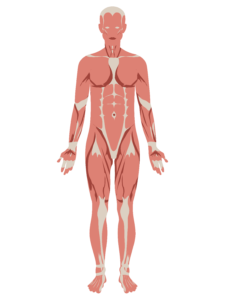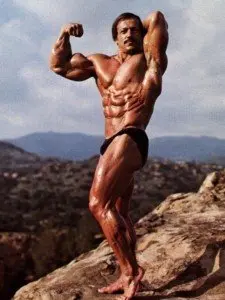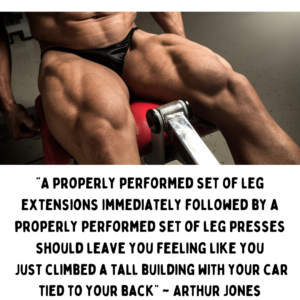There are many ways to structure your high intensity workout. Depending on factors such as the available equipment, fitness goals and personal preferences you can design a very wide variety of specific workouts. There is not just one “best” workout. Training with good form and high intensity effort are the vital elements for getting a good workout and good results. Allowing for full recovery and training consistently are important keys to getting long range benefit from HIT workouts.
Exercise Selection and Sample High Intensity Workouts Workouts
Generally, a HIT workout will be a full body routine that exercises the major muscle groups of the skeletal muscular system. The major muscle groups usually targeted for resistance training include –
Quadriceps (front of upper leg)
Glutes (butt and hips)
Hamstrings (back of upper leg)
Calves (lower leg)
Pectoralis (chest)
Trapezius (traps) (top of shoulders)
Latissimus dorsi (lats) – (large pulling muscle of the back)
Biceps (front of upper arms)
Triceps (back of upper arms)
Forearms (lower arm)
There is a wide variety of equipment that may be available to you if you choose to perform HIT workouts. These may be strength training machine (of which there is a very wide variety, some are excellent and some are poor) barbells, dumbbells, resistance bands and bodyweight exercises. This means you have pretty much an infinite variety of specific workouts you can perform. There are some biomechanical factors that indicate that some exercises may be superior to others. Also some people may have physical limitation for various reason. The important thing to keep in mind is to train all the large, main muscle groups and to apply high intensity training principle to you HIT workouts.
The BIG FIVE Workout
All the major muscles are important and significantly useful for many reasons. Do not think that they all need to be exercised in every single workout. In the outstanding book Body By Science authors McGuff and Little suggest a basic workout of just five exercises that will provide an outstanding overall full body training effect. This famous “Big Five Workout” includes –
Leg Press
Chest Press
Pulldown
Seated Row
Overhead Press
While this represents a short and simple workout, some people view The Big Five as rather basic. But as with all HIT training routines there are three important keys. These are to always use proper form, work to muscle failure and allow for full recovery and adaptation between workouts. Obviously, the equipment that is available to you dictates what exercises you can perform. Also, various biomechanical factors determine that some exercises are better than others. Below are just a few additional sample exercise routines for you to consider and perhaps adapt to your personal preferences.
Deep Fitness HIT Workouts
In the recent book Deep Fitness by Philip Shepherd and Andrei Yakovenko, the authors go into detail on the scientific aspects of HIT along with the physical and mental benefits of High Intensity Training. They stress the importance of proper mental focus while training. In addition they illustrate in detail several full body workouts to use with high intensity training principles. Here is one listed below .
Leg Curl
Leg Extension
Leg Press
Seated Row
Shoulder Press
Pulldown
Ab Isolator
Hip Abduction
Hip Adduction
Dr. Ellington Darden HIT Workouts
Dr. Ellington Darden, PHD, is a prolific writer and researcher on the topic of high intensity training. In one of his many outstanding books, The New high Intensity Training, he lists many workouts. Here is just one –
leg curl machine
leg extension machine
leg press machine
standing calf raise machine
bench press with barbell
bent over row with barbell
lateral raise with dumbbells
shoulder shrug with barbell
bent arm fly with dumbbells
tricep extension with dumbbell
biceps curl with barbell
trunk curl (crunches) on floor
Body building using HIT Workouts
Despite what many bodybuilders and want-to be bodybuilders may say, the method of single set HIT workouts can be very effective for participants in that sport. Traditional bodybuilding training is done with high volume, lower intensity, greater frequently and with poor form compared to scientific, safe and effective high intensity training. Going back in history a bit, individuals such as Mike Mentzer, Dave Mastorakis, Casey Viator, Boyer Coe, Dorian Yates, Sergio Oliva, Gordon LaVelle, Lee Labrada and many others have been the sports outcasts in that they trained primarily using the basic high intensity training method.
Casey Viator, the youngest ever Mr. American is famously know for conducting this workout, under the guidance of Arthur Jones, shortly before capturing that Mr. America title. Keep in mind that Casey Viator was an exceptionally strong individual with outstanding and above average genetic capability to develop his muscle structure. This information is printed here with the courtesy of Matt Brzycki’s High Intensity Training Program which can be located here https://staff.washington.edu/griffin/brzycki.html
HIGH INTENSITY TRAINING III: On June 10, 1971–two days before he won the Mr. America contest at the age of 19–Casey Viator went through this workout (Kids, don’t try this at home):

EXERCISE EQUIPMENT REPS WEIGHT (lbs.)
leg press Universal 20 750
leg extension Universal 20 225
squat barbell 13 502
two minute rest
leg curl Universal 12 175
1-leg calf raise dumbbell 3 X 15 40
pullover Nautilus 11 400
behind-the-neck Nautilus 10 200
rowing Nautilus 10 200
Pulldown Nautilus 10 210
two minute rest
lateral raise dumbbell 9 40
behind-neck press barbell 10 185
two minute rest
bicep curl Nautilus 8 110
chin bodyweight 12 BW
two minute rest
tricep extension Nautilus 9 125
parallel bar dip bodyweight 22 BW
If the numbers don’t impress you get this: Viator performed the leg portion of this routine in 11 minutes and the upper body part in 17 minutes and 40 seconds! It should also be noted that the Nautilus equipment manufactured 20 years ago wasn’t generally anywhere near as frictionless as that of today. Because when you lift a weight on a machine you are lifting the weight plus any mechanical friction, 400 pounds on a 1970 Nautilus pullover would’ve felt much heavier than 400 pounds on a 1994 friction-reduced model.

David M. Waters received his Bachelor of Science Degree in Physical Education from the University of
Massachusetts at Amherst. His extensive professional experience in field of fitness includes work as a personal training
instructor, fitness director, competitive athlete, author and fitness facility manager. Having been involved with
exercise and fitness training since 1979, he has had the opportunity to help countless individuals as a physical
fitness educator, promoting exercise as a part of an active and healthy lifestyle.
David is the author of The Fitness Center Handbook which was originally written and published in 1988 and has been completely edited and updated for this current publication. Copyright registered with the US Library of Congress, 1988.
The information contained on this website is for educational purposes only. No attempt at prescribing an exercise
program has been made. The author shall not be held liable or responsible for any injury or damage resulting
from any individual’s participation in any exercise program. Individuals should consult with their physician prior to
undertaking an exercise program.
————————————————————————————————————————–
The fitness information is provided for general informational and educational purposes only and is not a substitute for professional advice. Accordingly, before taking any actions based upon such information, we encourage you to consult with the appropriate professionals. We do not provide any kind of fitness advice. THE USE OR RELIANCE OF ANY INFORMATION CONTAINED ON THE SITE OR OUR MOBILE APPLICATION IS SOLELY AT YOUR OWN RISK.
________________________________________________________________________